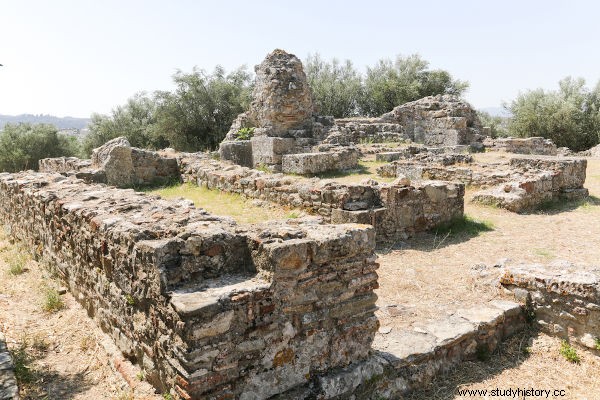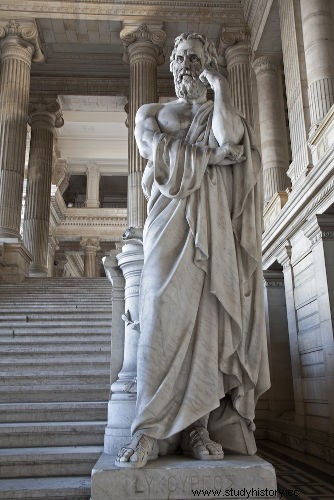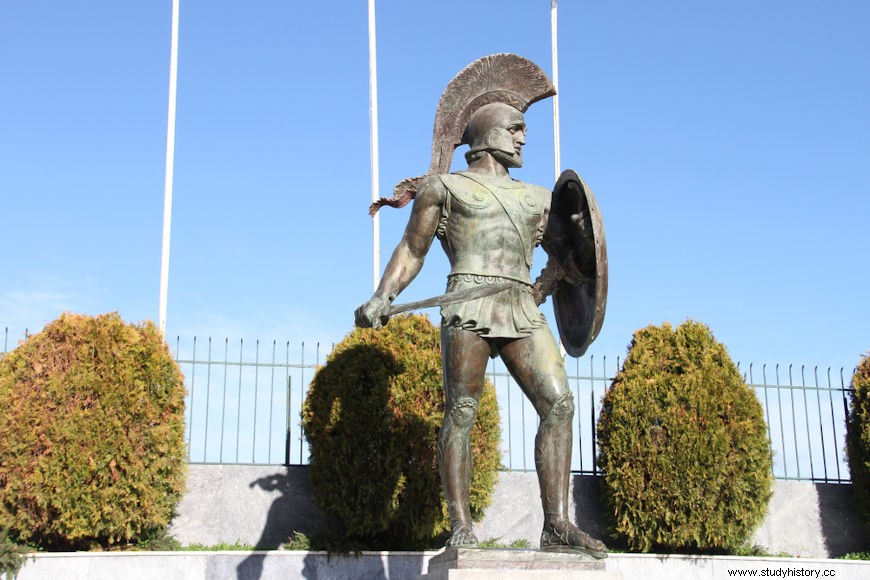Sparta it was one of the largest polis of Ancient Greece, and during the Classical Period it was the city that dominated the Peloponnese region. Historians believe that it emerged during the Homeric Period and that, from the 7th century BC, it began to grow, becoming the hegemonic force in the region.
It had a rigid society, with no possibility of social mobility and very militarized. The aristocracy was formed as an elite military corps, and only they could participate in politics, either giving their opinion or holding political office. The city of Sparta went into decline from the 4th century BC.
Read more :Cretans and Mycenaeans - the two civilizations that were part of the Pre-Homeric Period
Foundation and mythical origin

Sparta, with other polis such as Athens and Thebes, It was one of the most important city-states of Ancient Greece. It was located in the Laconia region , which is located on the Peloponnese Peninsula, southern Greece. Historians have evidence that points out that the human presence in the Sparta region is confirmed since the Neolithic.
However, the city of Sparta only appeared around the 10th century, during the Period Homeric . Historians believe it was founded by the Dorians , who invaded Greece around 1200 BC. The Dorians are well known for being one of the peoples who attacked Mycenaean cities at the end of the Pre-Homeric Period.
In the mythical narrative of the Spartans, the city would have been founded by Lacedemon , son of Zeus and Taygeth. The Greek myth tells that Lacedemon married Sparta, daughter of Eurotas, a mythical king who descended from Lélex, king of the native people of Laconia. After Lacedaemon assumed the throne of Laconia, he named the region after him (Laconia is also known as Lacedaemon) and named the city of Sparta after his wife.
Centuries after the city was established by the Dorians in Laconia, the Spartan population began its expansion across the peninsula. Historians believe that, around the 7th century BC, the Spartans would have attacked and conquered the region of Messenia , neighboring Laconia. Once Messenia was conquered, the local populations would have come under the control of Sparta, which became the polis with the largest territorial domain in all of Greece.
Organization of Spartan Society
It is a fact known to many that in the city of Sparta there was, politically and socially, a society rigid , based on the order , in the discipline and in militarism . In the Spartan case, this rigidity was expressed in such a way as to form a society with little social mobility, in which violence was often used to keep the population under control.
We say that, around the 7th century BC, the Spartans conquered Messenia, placing it under their rule. Greek sources point out that the local populations of Messenia were subjugated and turned into serfs. These people in a state of servitude and all their offspring were the hilotas , Sparta's largest social class.
However, modern historians have believed that the Helots originated from Laconia itself, and there are even Greek writings that claim that they were the Lacedaemonians who did not participate in the war against Messenia. Regardless of their origin, helots were considered servants in Sparta and were forced to work in the lands of the aristocracy.
As the helots were a numerically far superior group to the Spartan aristocracy and as they did not have many rights, the Spartans feared that a helot revolt would happen. To avoid this, they used origin myths to justify the power of the aristocrats, but also violence to ensure control over the helots.
A common practice of the Spartans was to send young men in military training to the lands inhabited by the helots with the aim of killing as many as possible. This act was known as crypteia and was part of a rite of passage for young men in military training who were turning 18.
In the crypt, the young soldier was sent to the Helot villages with a dagger and some food. During this process, he slept during the day and at night he went hunting for helots, killing anyone who crossed his path. Soldiers in formation could also attack the helots during the day, while they were distracted with work.
The class that exploited the work of the helots and placed them under this regime of violence was the Spartciates , the Spartan aristocracy. This was a very small group of men who had privileges and owned the productive lands. Spartiates referred to themselves as homoioi , which means “equal”.
Spartiates were Spartan citizens, that is, those who possessed political rights . In addition to being the sole owners of land (called kleroi ), they were the only ones who participated in politics, either giving opinions or occupying political positions. As the Spartans' entire livelihood was derived from the production of the helots and periecos, this elite could fully dedicate themselves to the two activities that were the basis of their life:politics and war.
In the case of politics, we have already seen that they were the only ones who gave opinions and held positions. In warfare, the Spartans formed the elite corps of the Spartan army and were a group of highly trained men who devoted their entire lives to acquiring skills for warfare. This took place through an educational process that began in childhood and extended into adulthood.
In the middle of the Spartan social pyramid were the periecos , an intermediate class of free men who played, mainly, the role of merchants, but who could also dedicate themselves to craft activities. The role of periecos was fundamental for the Spartans because they performed jobs that they could not do in life.

Although they were free men, periecos were also not considered citizens, so they did not participate in politics. In addition, this group could also be victims of violence conducted by the Spartans. This rigid social structure, as well as the Spartan political system, is believed to have been crafted, around the 8th century BC, by a mythical lawgiver named Lycurgus .
Login also :Spartan Laconism - Important Practice of Spartan Politics
Spartan politics
Spartan policy was also a rigid structure, and, as we have seen, is believed to have been formulated by Lycurgus. Unlike Athens, political participation in Sparta was more restricted and only Spartans had this privilege. This class comprised a maximum of nine thousand people who were seen as fit for government.
This makes Sparta a model polis aristocratic , because only the aristocracy was understood as a citizen. Sparta was ruled by a diarchy , that is, a government that had two kings, being heirs of families that exercised this function, according to the myth of Greek origin, since the descendants of Heracles returned to Laconia and settled in the region, together with the Dorians.
The Spartan diarchy had kings from the Agid dynasties and the Eurypontids, and both fulfilled religious, military and judicial functions. In times of war, one of the kings went to the battlefield, leading the Spartan troops, while the other one stayed in Sparta, guaranteeing the security and social order of the city.
In addition to the two kings, Spartan politics had three other institutions:the Appeal, the Gerusia, and the Council of Ephori. The Appeal it was the place where decision-making took place, being, therefore, a kind of assembly. In it all Spartans over 30 years old could meet to approve or reject the proposals made by Gerusia.
The Gerusia , in turn, functioned as a Senate for the Spartans. It brought together 28 Spartans over the age of 60 who were elected by Apel to hold the position for life. In addition, the two kings were also part of Gerusia. It was the role of its members to formulate laws to be voted on in the Appeal and to carry out the trial of people.
Finally, the Council of the Ephors it was made up of five Spartans elected to occupy the position for one year. The members of this council were the most powerful men in Sparta, and it was their job to monitor the work of the kings. That's why historians claim that the Ephorate was the most politically powerful institution in Sparta.
Login also :Dominion of Macedonia - the greatest reign of the Hellenistic Period
Strong Facts of Sparta
The city of Sparta maintained this political and social organization and lived at the height of its power during the Classical Period of Greek history. Evidently, the greatness and strength of Sparta did not come out of nowhere, but were the result of the growth that the city went through during the Archaic Period, especially from the 7th century BC.
The 6th century BC and V B.C. they were then the heyday of Sparta. The great sequence of conflicts that the city lived, from the end of the 5th century BC. and during the 4th century BC, it contributed to its weakening and losing its prominence in Greece.
During the Classical Period, Sparta was the strongest force in the Peloponnese region. It was with this power in mind that the city decided to create the Peloponnese League , which brought together the region's polis, with the exception of Argos, Sparta's regional rival. In that league, the great evident force was Sparta, that took advantage of its condition to obtain advantageous agreements with the other members.
League members also had a kind of defensive pact , thus, the Spartans had the guarantee of reinforcement in case it was necessary to protect themselves from the helots. These military contributions were, however, used exclusively during periods of war, and the number of soldiers was defined by the Spartan government. In addition, members were not required to pay a tax, as Athena did with the members of the Delian League.
Athens, by the way, was the biggest rival from Sparta throughout Greece . The Spartans despised the Athenians' democratic model. A great threat ended up causing the two cities to forget their differences and unite with others in a Hellenic league. This league of Greek cities came together to fight the Persian invaders during the Wars Medical .
This war took place in two phases, in which the Persians mobilized forces to invade Greece, but were defeated. The first phase took place between 492-490 BC, with the Persians led by Darius I . The conflict began as a reaction of the Persians to the Greek support offered to the Ionian cities that rebelled against the Persian rule in Asia Minor.
Darius I decided to organize a punitive expedition against the Greeks, but was defeated. Ten years later, the Persian king Xerxes organized a new expedition, starting the second phase (480-479 BC) of the conflict, but was also defeated. If Athens and Sparta teamed up to defeat the Persians, Sparta's other rival city — Argos — did not do the same, remaining neutral.

The Spartans contributed decisively to the victory of the Greeks against the Persians, and one of the best known episodes was that of the Battle of Thermopylae , in which 300 Spartan hoplites led by Leonidas I held off the Persian forces, made up of about 80,000 men, for three days.
After the Medical Wars, the city of Athens came out as the great force of Greece and, at the head of the Delian League, he began to enrich himself rapidly. This caught the attention of Sparta, causing the rivalry of the two polis to increase . Athenian intervention in Sparta's allied polis started the Peloponnesian War , a conflict that lasted from 431 BC. to 404 BC
Sparta won this last war, but its dominance over Greece caused the Greek polis to rise decades later. Between 395-387 BC, the Spartans fought Thebes, Corinth, Athens and Argos in the War from Corinth . In 371 BC, defeated at the Battle of Leuctra, the city of Sparta entered a period of decadence and never regained the power of other times.
